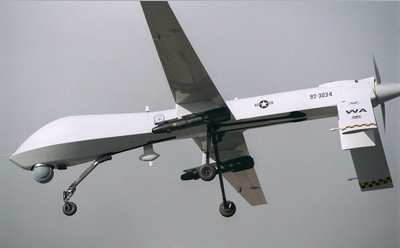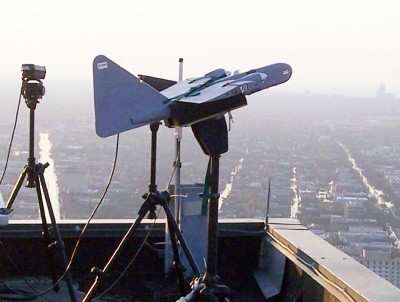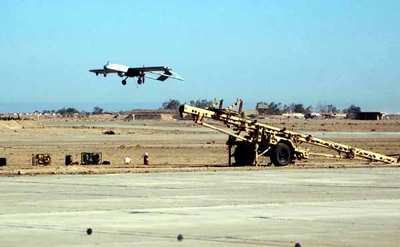Sat, Apr 19, 2008
Six Unmanned Aircraft Part Of Display
 Starting Thursday April 24, visitors to the National Air and
Space Museum will get a glimpse of six aircraft representing a
cross section of modern unmanned flight technology in the new
"Military Unmanned Aerial Vehicles" exhibition.
Starting Thursday April 24, visitors to the National Air and
Space Museum will get a glimpse of six aircraft representing a
cross section of modern unmanned flight technology in the new
"Military Unmanned Aerial Vehicles" exhibition.
UAVs are used by all four military branches for missions ranging
from reconnaissance and surveillance to attack and each branch is
represented in this exhibit: Predator, DarkStar, X-45A (Air Force);
Shadow 200 (Army); Dragon Eye (Marine Corps); and Pioneer (Navy).
Likewise, a wide variety of technologies are on display: jets,
piston-driven props and electric motors for propulsion; and
surveillance radars, precision bombs and missiles for combat
use.
"The UAVs are positioned over 'In Plane View: Abstractions of
Flight,' a photographic exhibition of visually intriguing elements
of aircraft and spacecraft," museum director Gen. J.R. "Jack"
Dailey said. "By installing the two displays together, we hope to
suggest parallels between technology, culture and the arts,"
The first true UAVs -- aerial vehicles capable of returning to a
successful recovery after the prescribed mission -- were developed
in the late 1950s, but America’s military began looking into
the use of unmanned aerial vehicles during World War I. Both the
Army and Navy built functional unmanned aircraft before the war
ended in November 1918. During World War II, unmanned craft had
developed to the point where they could be controlled from a remote
location by radio signals, usually sent from another aircraft
following behind. Modern UAVs are technologically advanced aircraft
but would be incomplete without effective command and control,
especially trained support personnel, effective mission-related
sensors and particular weapons that enable mission
accomplishment.
The following UAVs will be featured in the new exhibition:
- General Atomics Aeronautical Systems, Inc., MQ-1L
Predator A: The Predator (below) is capable of both
reconnaissance and attack missions. It has been used in the
Balkans, Afghanistan, Iraq and other global locations. The U.S. Air
Force Predator displayed flew 196 combat missions in the skies of
Afghanistan and was one of the first three UAVs to fly operational
missions there after the 9/11 terrorist attacks. The Predator
Development Team won the 2002 National Air and Space Museum Trophy
for Current Achievement.

- Lockheed Martin/Boeing RQ-3A DarkStar: The
DarkStar was developed by Lockheed Martin Skunk Works and Boeing
Defense and Space Group to provide sustained reconnaissance
information from anywhere within enemy territory, day or night, in
all types of weather.
- AeroVironment RQ-14A Dragon Eye: In early
2001, the Naval Research Laboratory and the US Marine Corps
Warfighting Laboratory designed and built the Dragon Eye
reconnaissance mini-UAV. Dragon Eye (below) is a fully autonomous,
hand- or bungee-launched UAV designed to provide tactical
reconnaissance and surveillance information to field commanders.
The Dragon Eye is on display in a case also containing its computer
control, eye goggles (to see what the sensors see), a
parts-and-tool kit and bungee-cord launching system.

- Pioneer UAV Inc. (IAI/AAI) RQ-2A Pioneer: The
Pioneer performs a wide variety of reconnaissance, surveillance,
target acquisition and battle damage-assessment missions.
Pioneer’s electro-optical sensors and infrared camera provide
real-time images of the target area to field commanders. The
vehicle on display served with the U.S. Navy during the 1991 Gulf
War. On one notable mission, a group of Iraqi fighters surrendered
to the vehicle as it flew over their heads. Marines were directed
to their position, where they then captured the fighters.
- AAI Corporation RQ-7A Shadow 200 (Tactical Unmanned
Aerial Vehicle): The RQ-7A (below) is a twin-boom pusher
design and has non retractable tricycle landing gear for
conventional, wheeled takeoff and landing. The RQ-7A also can be
launched from a catapult and has a tail hook to catch arresting
cables for a shorter landing run. Screamin’ Demon flew with
the U.S. Army’s 4th Infantry Division, Stryker Brigade Combat
Team No. 2, and the 82nd Airborne Division. Its last combat flight
in Iraq took place Sept. 12, 2005, totaling 124 missions and nearly
500 flight hours.

- Boeing X-45A Joint Unmanned Combat Air System
(J-UCAS): The X-45A (below) was the first modern unmanned
aerial vehicle designed specifically for combat strike missions.
The X-45A first flew in May 2002. Air vehicle No. 1 performed the
first autonomous flight of a high-performance, combat-capable UAV;
the first weapons release from an autonomous UAV; and, with air
vehicle No. 2, the first autonomous multi-vehicle coordinated
flight.

This exhibition is made possible though the generosity of
General Atomics Aeronautical Systems, Inc., builder of the Predator
UAV.
More News
Also: Vertical Flight Society, NBAA Maintenance Conference, GA Honored, AMT Scholarship For the first time, students from Embry-Riddle’s Daytona Beach, Florida, campus took t>[...]
Hazardous Weather Information Summary of significant meteorological information (SIGMET/WS), convective significant meteorological information (convective SIGMET/WST), urgent pilot>[...]
"The need for innovation at speed and scale is greater than ever. The X-62A VISTA is a crucial platform in our efforts to develop, test and integrate AI, as well as to establish AI>[...]
(FAA) Inspector Observed That Both Fuel Tanks Were Intact And That Only A Minimal Amount Of Fuel Remained In Each Analysis: According to the pilot, approximately 8 miles from the d>[...]
“Pyka’s Pelican Cargo is unlike any other UAS solution on the market for contested logistics. We assessed a number of leading capabilities and concluded that the Pelica>[...]
 Airborne-Flight Training 05.09.24: ERAU at AIAA, LIFT Diamond Buy, Epic A&P
Airborne-Flight Training 05.09.24: ERAU at AIAA, LIFT Diamond Buy, Epic A&P ANN's Daily Aero-Term (05.07.24): Hazardous Weather Information
ANN's Daily Aero-Term (05.07.24): Hazardous Weather Information Aero-News: Quote of the Day (05.07.24)
Aero-News: Quote of the Day (05.07.24) NTSB Final Report: Cessna 150
NTSB Final Report: Cessna 150 Aero-News: Quote of the Day (05.08.24)
Aero-News: Quote of the Day (05.08.24)







